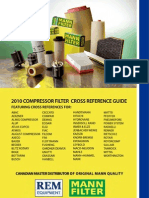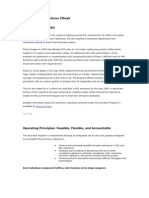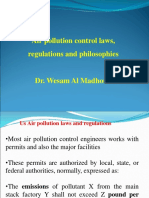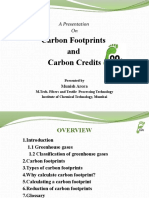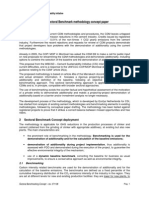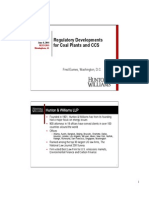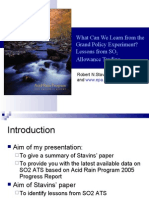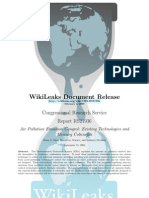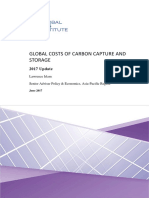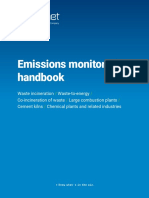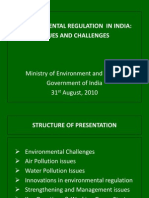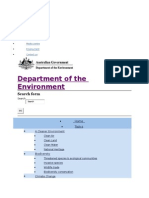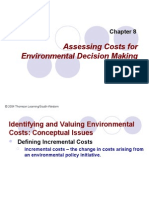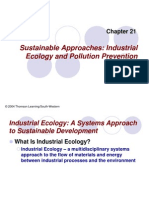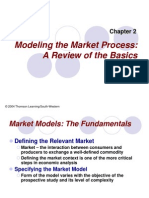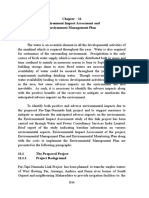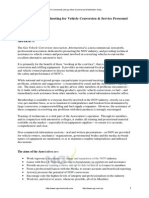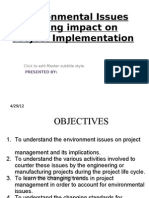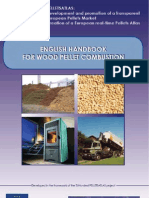0 ratings0% found this document useful (0 votes)
30 viewsImproving Air Quality: Controlling Stationary Sources: © 2004 Thomson Learning/South-Western
Improving Air Quality: Controlling Stationary Sources: © 2004 Thomson Learning/South-Western
Uploaded by
Arina Farihan AzharControlling Stationary Sources Stationary sources contribute to the emissions levels of all the criteria pollutants. Technology-based standards are used to set emissions limits for new Stationary Sources. A new source has to meet a standard that aligns with the maximum degree of pollution reduction available.
Copyright:
Attribution Non-Commercial (BY-NC)
Available Formats
Download as PPT, PDF, TXT or read online from Scribd
Improving Air Quality: Controlling Stationary Sources: © 2004 Thomson Learning/South-Western
Improving Air Quality: Controlling Stationary Sources: © 2004 Thomson Learning/South-Western
Uploaded by
Arina Farihan Azhar0 ratings0% found this document useful (0 votes)
30 views21 pagesControlling Stationary Sources Stationary sources contribute to the emissions levels of all the criteria pollutants. Technology-based standards are used to set emissions limits for new Stationary Sources. A new source has to meet a standard that aligns with the maximum degree of pollution reduction available.
Original Title
EE12
Copyright
© Attribution Non-Commercial (BY-NC)
Available Formats
PPT, PDF, TXT or read online from Scribd
Share this document
Did you find this document useful?
Is this content inappropriate?
Controlling Stationary Sources Stationary sources contribute to the emissions levels of all the criteria pollutants. Technology-based standards are used to set emissions limits for new Stationary Sources. A new source has to meet a standard that aligns with the maximum degree of pollution reduction available.
Copyright:
Attribution Non-Commercial (BY-NC)
Available Formats
Download as PPT, PDF, TXT or read online from Scribd
Download as ppt, pdf, or txt
0 ratings0% found this document useful (0 votes)
30 views21 pagesImproving Air Quality: Controlling Stationary Sources: © 2004 Thomson Learning/South-Western
Improving Air Quality: Controlling Stationary Sources: © 2004 Thomson Learning/South-Western
Uploaded by
Arina Farihan AzharControlling Stationary Sources Stationary sources contribute to the emissions levels of all the criteria pollutants. Technology-based standards are used to set emissions limits for new Stationary Sources. A new source has to meet a standard that aligns with the maximum degree of pollution reduction available.
Copyright:
Attribution Non-Commercial (BY-NC)
Available Formats
Download as PPT, PDF, TXT or read online from Scribd
Download as ppt, pdf, or txt
You are on page 1of 21
Chapter 12
Improving Air Quality: Controlling Stationary Sources
2004 Thomson Learning/South-Western
Controlling Stationary Sources
Stationary sources contribute to the emissions levels of all the criteria pollutants; this group includes:
Electric power plants Chemical plants Steel mills Residential furnaces
Regulated by technology-based standards
Controlling Stationary Sources
Figure 12.1 National Emissions Estimates for Stationary Sources by Major Category, 1999
Controlling Stationary Sources
Age-Specific Control Differences: New Versus Existing Sources
Defining technology-based emissions limits New source performance standards (NSPS) technology-based emissions limits established for new stationary sources Dual-control approach
New or modified stationary source a source for which construction or modification follows the publication of regulations Existing stationary source a source already present when regulations are published
4
Controlling Stationary Sources
Bubble policy allows a plant to measure its emissions as an average of all emission points emanating from that plant Emissions banking allows a source to accumulate emission reduction credits if it reduces emissions more than required by law and to deposit these through a banking program
Controlling Stationary Sources
Location-Specific Control Differences: PSD Versus Nonattainment Areas
Defining Emissions Limits in PSD Areas Best available control technology (BACT) a new source has to meet a standard that aligns with the maximum degree of pollution reduction available
Emissions trading in PSD areas Netting developed for PSD areas to allow emissions trading among points within a source for the same type of pollutant, such that any emissions increase due to a modification is matched by a reduction from another point within that some source
6
Controlling Stationary Sources
Emissions Trading in Nonattainment Areas Offset plan developed for nonattainment areas to allow emissions trading between new or modified sources and existing facilities such that releases from the new or modified source are more than countered by reductions achieved by existing sources
To facilitate the plan, an emissions bank of accumulated emission reduction credits was set up where facilities could deposit and access offsets as needed
Controlling Stationary Sources
Sorting It Out Emissions limits for PSD areas are more stringent than in Nonattainment Areas Limits for New Sources are more stringent than those for Existing Sources within both types of areas
Controlling Acidic Deposition
Regional pollution problem source of the contamination is often hundreds of miles from where the detrimental effects are felt
Controlling Acidic Deposition
The Problem of Acidic Deposition
Acidic deposition arises when sulfuric and nitric acids mix with other airborne particles and fall to the earth as dry or wet deposits
10
Controlling Acidic Deposition
The Policy Response: Title IV of the 1990 Amendments
SO2 Emissions Allowance Program Tradeable SO2 emission allowances permits issued to stationary sources, each allowing the release of one ton of SO2 which can be either held or sold through a transfer program
11
Economic Analysis of Stationary Source Controls
Relative Cost of Using Command-andControl Instruments
The lack of flexibility in a standards-based approach adds significantly to societys costs and offers no incentive to low-cost abaters to clean up beyond the statutory level In most instances society should realize important cost savings from a shift to more flexible policy instruments with no reduction in air quality benefits
12
Economic Analysis of Stationary Source Controls
Uniform Technology-Based NSPS
Two potential problems with the new source performance standards (NSPS) Implemented uniformly Technology-based standards
13
Economic Analysis of Stationary Source Controls
Figure 12.2 Cost-Ineffectiveness of the Uniform New Source Performance Standard
14
Economic Analysis of Stationary Source Controls
Figure 12.3 Analysis of the NSPS in the 1977 Clean Air Act Amendments According to Perl and Dunbar (1982)
15
Economic Analysis of Stationary Source Controls
The Dual-Control Approach and the New Source Bias
Dual-control approach gives states more direct supervision over those firms on which their economies have come to depend Can generate market distortions
16
Economic Analysis of Stationary Source Controls
Economics of Market-Based Trading Programs
Analysis of Emissions Trading Ultimately, all sources will control pollution to the point where the marginal abatement cost of doing so is equal across firms a cost effective solution
17
Economic Analysis of Stationary Source Controls
Figure 12.4 Analyzing the Dual-Control Approach and the New Source Bias: Marginal Abatement Cost Levels for New Versus Existing Sources
18
Economic Analysis of Stationary Source Controls
Analysis of the 1990 SO2 allowance trading plan Firms with excess allowances become suppliers in the market Firms unable to match their emissions level to their number of held allowances become demanders On net, buyers and sellers will trade for allowances, and emissions levels should reach the level where MACs are equal across firms
19
Economic Analysis of Stationary Source Controls
Figure 12.5 Cost-Effectiveness of the SO2 Allowance Trading Plan
20
Economic Analysis of Stationary Source Controls
Figure 12.6 Comparison of Intrautility and Interutility SO2 Allowance Trades through 2001
21
You might also like
- Lesson 2 Philippine Environmental LawsDocument44 pagesLesson 2 Philippine Environmental LawsGlen Mangali100% (21)
- Mann-Compressor Cross Reference GuideDocument104 pagesMann-Compressor Cross Reference GuideEliasd91% (11)
- Improving Air Quality: Controlling Mobile Sources: © 2004 Thomson Learning/South-WesternDocument13 pagesImproving Air Quality: Controlling Mobile Sources: © 2004 Thomson Learning/South-WesternArina Farihan AzharNo ratings yet
- Emissions Data: Top of PageDocument15 pagesEmissions Data: Top of PagetejalmestryNo ratings yet
- RAP Cowart NEDRIOverview 2004-07-12Document17 pagesRAP Cowart NEDRIOverview 2004-07-12raul_bsuNo ratings yet
- Air PollutionDocument37 pagesAir Pollutionhitesh chaudharyNo ratings yet
- Air Pollution Control Laws, Regulations and PhilosophiesDocument37 pagesAir Pollution Control Laws, Regulations and Philosophieshitesh chaudharyNo ratings yet
- Philippine Clean Air ActDocument33 pagesPhilippine Clean Air ActSheedah BonifacioNo ratings yet
- Methane Reduction PlanDocument13 pagesMethane Reduction Plan2rQiTPh4KnNo ratings yet
- EMS Lecture 7 2020.173725.1582511094.7877Document40 pagesEMS Lecture 7 2020.173725.1582511094.7877Pun AditepNo ratings yet
- Clean Power PlanDocument40 pagesClean Power PlanOnupamNo ratings yet
- Ns R ReformsDocument83 pagesNs R ReformsG Alex QSNo ratings yet
- Intl Environmental LawDocument10 pagesIntl Environmental LawJeff SanchezNo ratings yet
- Key Concepts of Clean Air Act: Hazardous Air Pollutants (Haps)Document14 pagesKey Concepts of Clean Air Act: Hazardous Air Pollutants (Haps)zmcxlxcz lzxljaljdaNo ratings yet
- Carbon Footprints and Carbon Credits by MunishDocument33 pagesCarbon Footprints and Carbon Credits by MunishMunish Arora100% (2)
- HCFC Phase Out Strategies RAC Aug 09Document5 pagesHCFC Phase Out Strategies RAC Aug 09ALFARMNo ratings yet
- Attachment 3 - Concept PaperDocument5 pagesAttachment 3 - Concept PaperRatnakar MahajanNo ratings yet
- Carbon Markets Glossary of TermsDocument6 pagesCarbon Markets Glossary of TermsGreyce MaasNo ratings yet
- Final1 Ecoquest Finalreport PDFDocument58 pagesFinal1 Ecoquest Finalreport PDFAdlin RajNo ratings yet
- Epa Requirements For Emergency EnginesDocument10 pagesEpa Requirements For Emergency EnginesMocharu ArtNo ratings yet
- Technical Paper On The Federal Carbon Pricing BackstopDocument22 pagesTechnical Paper On The Federal Carbon Pricing BackstopCPAC TVNo ratings yet
- Lecture 10 On Pollution ControlDocument22 pagesLecture 10 On Pollution Controlii muNo ratings yet
- Summary ProcessingDocument3 pagesSummary ProcessingakonucheNo ratings yet
- Using Marginal Damages in Environmental Policy: A Study of Air Pollution in the United StatesFrom EverandUsing Marginal Damages in Environmental Policy: A Study of Air Pollution in the United StatesRating: 5 out of 5 stars5/5 (1)
- Green AirportsDocument5 pagesGreen AirportsAnish BabuNo ratings yet
- Flue Gas Desulfurization - FGD - Performance CapabilityDocument80 pagesFlue Gas Desulfurization - FGD - Performance CapabilitydaveNo ratings yet
- Clean Dair Act (CAA)Document48 pagesClean Dair Act (CAA)Brian Montes BagarinaoNo ratings yet
- Regulatory Developments For Coal Plants and CCS: Hunton & Williams LLPDocument12 pagesRegulatory Developments For Coal Plants and CCS: Hunton & Williams LLPrecsco2No ratings yet
- 17 Stavins FINALDocument21 pages17 Stavins FINALapi-3747949No ratings yet
- 06 Air Pollution (Polusi Udara)Document11 pages06 Air Pollution (Polusi Udara)Ghani Abdul RofieNo ratings yet
- Externalities and The Environment: Public Sector Solutions To ExternalitiesDocument19 pagesExternalities and The Environment: Public Sector Solutions To ExternalitiesSherwin D100% (1)
- Clean Air ActDocument9 pagesClean Air Act지창욱No ratings yet
- Primer On Clean Air ActDocument9 pagesPrimer On Clean Air ActRyan Mervin Mamaradlo FerrerNo ratings yet
- 45 FR 52676 8-7-80Document74 pages45 FR 52676 8-7-80Ken ComeyNo ratings yet
- Benefit-Cost Analysis in Environmental Decision Making: © 2004 Thomson Learning/South-WesternDocument12 pagesBenefit-Cost Analysis in Environmental Decision Making: © 2004 Thomson Learning/South-WesternArina Farihan AzharNo ratings yet
- CRS - 2004 Air Pollution Emission Control Existing Technologies and Mercury CoBenefitsDocument7 pagesCRS - 2004 Air Pollution Emission Control Existing Technologies and Mercury CoBenefitsMercury ExposureNo ratings yet
- Republic Act 8749 Salient FeaturesDocument34 pagesRepublic Act 8749 Salient Featuresdenr02legal88% (8)
- Annex 18 Market SurveyDocument72 pagesAnnex 18 Market SurveyesmaealzadehhaNo ratings yet
- RAP Schwartz RPSpresentationOSU 2010-2-22Document25 pagesRAP Schwartz RPSpresentationOSU 2010-2-22Florabel Tolentino Sera JosefNo ratings yet
- Global Ccs Cost Updatev4 PDFDocument16 pagesGlobal Ccs Cost Updatev4 PDFTint LwinNo ratings yet
- Environmental Laws in IndiaDocument16 pagesEnvironmental Laws in IndiaRaGa JoThi100% (1)
- Business Roundtable Major Regulations of ConcernDocument19 pagesBusiness Roundtable Major Regulations of ConcernBusiness RoundtableNo ratings yet
- Types of Environmental StandardsDocument2 pagesTypes of Environmental StandardsadammzjinNo ratings yet
- Achieving Sustainable Energy Reduction in An Industrial SettingDocument2 pagesAchieving Sustainable Energy Reduction in An Industrial SettingKit OungNo ratings yet
- Environment Project Group 6Document11 pagesEnvironment Project Group 6paulsrija211805No ratings yet
- Gasmet EMISSIONS MONITORING HANDBOOKDocument38 pagesGasmet EMISSIONS MONITORING HANDBOOKarunkumar277041No ratings yet
- Value Engineering of Car Park Ventilation SystemDocument8 pagesValue Engineering of Car Park Ventilation SystemmitasyahuNo ratings yet
- 2023-04-17 Chapter13unit4Document13 pages2023-04-17 Chapter13unit4doshicherissa23No ratings yet
- Environmental Regulation in India: Issues and ChallengesDocument27 pagesEnvironmental Regulation in India: Issues and Challengesgirija_mallickNo ratings yet
- IWK 019017 Gas EmissionsDocument16 pagesIWK 019017 Gas EmissionsAlfred LamNo ratings yet
- L6 - Environmental Economics IIDocument14 pagesL6 - Environmental Economics IIsmithson JoeNo ratings yet
- BCMOE WTE Emissions FinalDocument325 pagesBCMOE WTE Emissions FinalJoseph Riley100% (1)
- Gold Standard AdditionalityDocument5 pagesGold Standard AdditionalityabcdefghdevenNo ratings yet
- Salient FeaturesDocument7 pagesSalient FeaturesAnny YanongNo ratings yet
- Pollution Trading: Cashing Out Our Clean Air and WaterDocument4 pagesPollution Trading: Cashing Out Our Clean Air and WaterFood and Water WatchNo ratings yet
- Lecture #10-Spring 2022Document5 pagesLecture #10-Spring 2022David GeorgeNo ratings yet
- Department of The Environment: Search FormDocument9 pagesDepartment of The Environment: Search FormChivuAlexandruNo ratings yet
- National Ambient Air Monitoring StrategyDocument31 pagesNational Ambient Air Monitoring Strategybalsam07No ratings yet
- Industrial Energy Efficiency Down UnderDocument64 pagesIndustrial Energy Efficiency Down UndercleitonmoyaNo ratings yet
- ESP TechnologiesDocument37 pagesESP TechnologiesSuchismita DhalNo ratings yet
- FWE200Document12 pagesFWE200Jorge Francisco Silva TapiaNo ratings yet
- Effective Competition Which Leads To Good Performance Is The Central Concept in I/O. VirtuesDocument13 pagesEffective Competition Which Leads To Good Performance Is The Central Concept in I/O. VirtuesArina Farihan AzharNo ratings yet
- Game Theory Competition Collusion Interdependent: Chapter 6: OligopolyDocument19 pagesGame Theory Competition Collusion Interdependent: Chapter 6: OligopolyTingWei LeeNo ratings yet
- Istanbul TurkeyDocument28 pagesIstanbul TurkeyArina Farihan AzharNo ratings yet
- IDE 5rDocument4 pagesIDE 5rArina Farihan AzharNo ratings yet
- CHAPTER 9: Price DiscriminationDocument12 pagesCHAPTER 9: Price DiscriminationArina Farihan AzharNo ratings yet
- Industrial Organization (IO) or Industrial Economics Is A Study ofDocument5 pagesIndustrial Organization (IO) or Industrial Economics Is A Study ofArina Farihan AzharNo ratings yet
- Chapter 3: Economics of Perfect Competition: Marginal Cost Pricing Shutdown Price Supply Curve Shutdown DecisionDocument4 pagesChapter 3: Economics of Perfect Competition: Marginal Cost Pricing Shutdown Price Supply Curve Shutdown DecisionArina Farihan AzharNo ratings yet
- Chapter 7: Product Differentiation and Monopolistic CompetitionDocument10 pagesChapter 7: Product Differentiation and Monopolistic CompetitionArina Farihan AzharNo ratings yet
- Benefit-Cost Analysis in Environmental Decision Making: © 2004 Thomson Learning/South-WesternDocument12 pagesBenefit-Cost Analysis in Environmental Decision Making: © 2004 Thomson Learning/South-WesternArina Farihan AzharNo ratings yet
- Assessing Costs For Environmental Decision Making: © 2004 Thomson Learning/South-WesternDocument12 pagesAssessing Costs For Environmental Decision Making: © 2004 Thomson Learning/South-WesternArina Farihan AzharNo ratings yet
- Controlling Toxic Chemicals: Production, Use, and Disposal: © 2004 Thomson Learning/South-WesternDocument15 pagesControlling Toxic Chemicals: Production, Use, and Disposal: © 2004 Thomson Learning/South-WesternArina Farihan AzharNo ratings yet
- Sustainable Approaches: Industrial Ecology and Pollution PreventionDocument23 pagesSustainable Approaches: Industrial Ecology and Pollution PreventionArina Farihan AzharNo ratings yet
- ND, NS, N & yDocument5 pagesND, NS, N & yArina Farihan AzharNo ratings yet
- Environmental Economics and Management:: Theory, Policy, and Applications 3eDocument16 pagesEnvironmental Economics and Management:: Theory, Policy, and Applications 3eArina Farihan AzharNo ratings yet
- Modeling The Market Process: A Review of The Basics: © 2004 Thomson Learning/South-WesternDocument27 pagesModeling The Market Process: A Review of The Basics: © 2004 Thomson Learning/South-WesternArina Farihan AzharNo ratings yet
- Nature of The Model: Macro Notes Section 1.4 Macro Flows Tutorial Section 1.3 Macro Flows Tutorial Section 1.2Document6 pagesNature of The Model: Macro Notes Section 1.4 Macro Flows Tutorial Section 1.3 Macro Flows Tutorial Section 1.2Arina Farihan AzharNo ratings yet
- Environmental Pollution Dissertation TopicsDocument7 pagesEnvironmental Pollution Dissertation TopicsBuyALiteratureReviewPaperUK100% (1)
- Logan Espr 2011Document347 pagesLogan Espr 2011Monica AstridNo ratings yet
- Par-Tapi-Narmada Link Project EIA PDFDocument83 pagesPar-Tapi-Narmada Link Project EIA PDFsumitNo ratings yet
- Plant Location and Site SelectionDocument34 pagesPlant Location and Site SelectionNaik LarkaNo ratings yet
- MR Project Soln Electric CarsDocument8 pagesMR Project Soln Electric CarsSaurabh SharmaNo ratings yet
- HipohoiebatkananghihipoDocument4 pagesHipohoiebatkananghihipoJarred Allen Z. ServañaNo ratings yet
- CE 2038 Scad Engineering College, Cheranmahadevi APMDocument17 pagesCE 2038 Scad Engineering College, Cheranmahadevi APMHanamant HunashikattiNo ratings yet
- 140 - Training & Troubleshooting Guide For NGV ConversionDocument7 pages140 - Training & Troubleshooting Guide For NGV ConversionAndres Fernando Sokol UrzagasteNo ratings yet
- 1.9 History Green Logistics - 085351Document8 pages1.9 History Green Logistics - 085351Luis DiazNo ratings yet
- IntroductionDocument3 pagesIntroductionJohn Destynn Mer VasquezNo ratings yet
- NMMC Esr - 2015-2016Document136 pagesNMMC Esr - 2015-2016hiyogsNo ratings yet
- Environmental Economics Dissertation TopicsDocument6 pagesEnvironmental Economics Dissertation TopicsWriteMyPaperOneDayUK100% (1)
- Outdoor Air QualityDocument6 pagesOutdoor Air QualityShintaMalindaNo ratings yet
- EST Priliumary Question PaperDocument14 pagesEST Priliumary Question Papervadapav2901No ratings yet
- 079254C-0000-JSD-6200-001 - 0 - Signed - EFFLUENT MANAGEMENT PHILOSOPHYDocument12 pages079254C-0000-JSD-6200-001 - 0 - Signed - EFFLUENT MANAGEMENT PHILOSOPHYmohamedriyad33No ratings yet
- Module 3 AnswerDocument26 pagesModule 3 AnswermarvsNo ratings yet
- Name - Syed Shahrukh Syed Habeeb Guided by - Prof. Rohit Kshirsagar Department of Mechanical Engineering Manav School of Engineering, AkolaDocument27 pagesName - Syed Shahrukh Syed Habeeb Guided by - Prof. Rohit Kshirsagar Department of Mechanical Engineering Manav School of Engineering, AkolaSyed ShahrukhNo ratings yet
- Assignment 2 Air PollutionDocument8 pagesAssignment 2 Air PollutionPradhumna AdhikariNo ratings yet
- Environmental Issues Having Impact On Project ImplementationDocument27 pagesEnvironmental Issues Having Impact On Project ImplementationPratibha KhemchandaniNo ratings yet
- Aim and ObjectiveDocument4 pagesAim and Objectiveankitcham460No ratings yet
- Control of Pollution in The Iron and Steel IndustryDocument19 pagesControl of Pollution in The Iron and Steel IndustryJoao MinhoNo ratings yet
- Air Quality:: Definitions, Characteristics, and PerspectivesDocument37 pagesAir Quality:: Definitions, Characteristics, and Perspectives^nana^No ratings yet
- Mae Moh Lignite Mine and Environmental ManagementDocument11 pagesMae Moh Lignite Mine and Environmental ManagementMaria Diamantopoulou100% (1)
- Philosophy of SafetyDocument34 pagesPhilosophy of Safetysuraj100% (1)
- Pellet HandbookDocument86 pagesPellet Handbookkiki_d100% (1)
- EX1 - Combustion Fumes - ExercisesDocument5 pagesEX1 - Combustion Fumes - ExercisesducanhNo ratings yet
- Granite Automatic Guarantee: 1 July 2013 VersionDocument28 pagesGranite Automatic Guarantee: 1 July 2013 Versionviagi81No ratings yet
- Ccs Potential IndonesiaDocument236 pagesCcs Potential Indonesiat3guhku2hNo ratings yet
- Pollution Thesis Statement ExamplesDocument4 pagesPollution Thesis Statement Examplescarmenmartinezmcallen100% (2)

